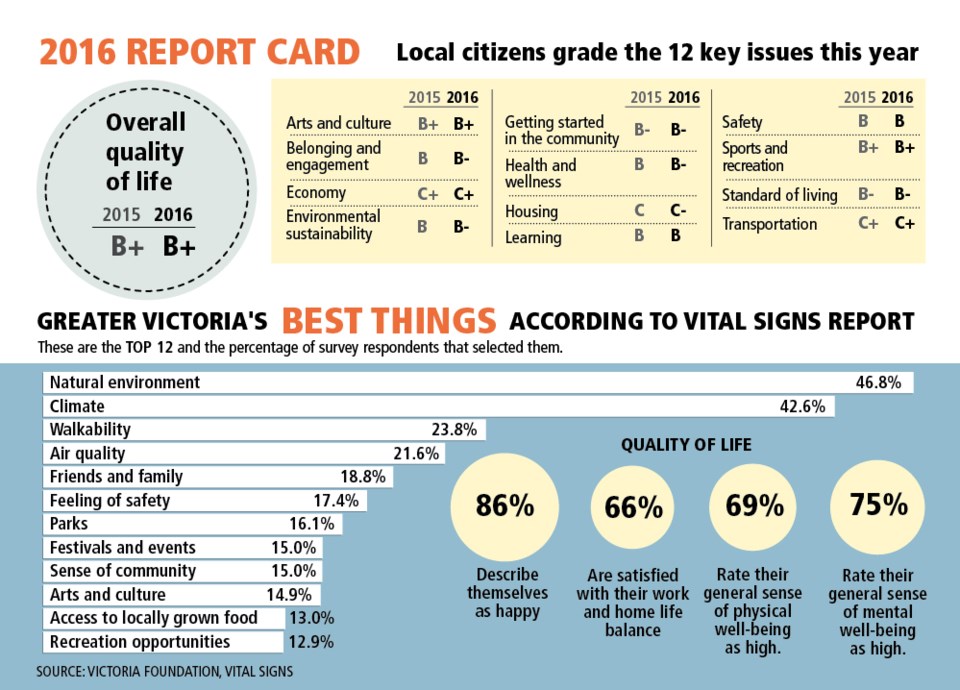Greater Victoria has too much housing for the wealthy and not nearly enough for those with low and moderate incomes, says a report released today by the Victoria Foundation.
The 2016 Vital Signs report is an annual snapshot of well-being in the capital region based on collected data and a citizen survey conducted in May and June.
According to the report, an estimated 64 per cent of housing being built in Greater Victoria is affordable to only 25 per cent of households.
“Housing always gets a low grade,” said Robert Janus, communications director for the charitable organization, which uses the report to help direct grants of millions of dollars each year, including $100,000 to help start the Aboriginal Coalition to End Homelessness last year.
This year, housing went down a grade, from a C to a C-, and was named along with homelessness as the most important issue in the city by 52.4 per cent of respondents. The cost of living was the second-biggest issue, cited by nearly half the 1,328 respondents.
“Not a single grade went up this year,” said Janus. “But there were no major declines, either.”
The report paints a picture of a booming housing market, with a 42 per cent increase in sales since last year and the highest level of rental construction since 1988. But it also shows worsening accessibility, with higher prices and fewer affordable choices.
The median sale price for a single-family home in 2015 was $557,250. In 2016, it was $665,000.
The rental vacancy rate is the lowest in the country at 0.6 per cent, and average rental rates are among the highest.
“This is a particular concern for low-income seniors,” said B.C. seniors advocate Isobel Mackenzie, noting 20 per cent of seniors in the province are renters, and many live on less than $1,800 a month. “Rent controls allow landlords to increase rents the cost of living plus two per cent, but seniors’ incomes don’t rise.”
Mackenzie said there are rental grants, but in some areas, such as the capital region, they fall short of actual rental costs. There are 1,840 seniors receiving subsidies for up to $650 a month in Victoria. However, the average rent for all unit types in Greater Victoria is $942 a month.
“Every year, the gap will grow,” she said, noting seniors have other unexpected expenses as they age, such as over-the-counter medication and aids, and things such as needing to have groceries delivered.
She said housing is the biggest issue she hears about from seniors, and she worries some seniors and their families might consider care homes because they are more affordable, not because the person is unable to live independently.
“We don’t want to see people moving because of housing rather than their care needs,” she said.
Janus said the news wasn’t all worrying in this year’s Vital Signs. The overall theme of the report is belonging. He noted 70 per cent of respondents ages 12 and older on the South Island said they felt a strong sense of belonging in the community, compared to 66 per cent of respondents nationally.
“One interesting shift was in response to: ‘Do you feel Greater Victoria is welcoming to new Canadians?’” he said. “This year, 60 per cent said yes. Last year, it was 50 per cent.”
Janus said the region’s much-publicized welcome and community sponsorship of Syrian refugees likely gets the credit.
“What’s in the media does show up in the responses,” he said, noting the tent city that sprang up on the courthouse lawn for several months likely kept homelessness on people’s minds.
Janus said the Vital Signs report “started out as a tool for us to do our job better … Now it’s part of our DNA.”
The report, in its 11th edition, helps direct grants to the community. The Victoria Foundation gives out about a million dollars each month, and helps donors direct funds to specific areas.
Vital Signs: Crime
Public safety in Greater Victoria gets a B grade, according to the Vital Signs survey, with violent crimes and sexual assaults up, but youth crime in decline.
The youth crime rate has declined 152 per cent since 2004. In 2015, the number of youths ages 12 to 17 charged with a violation — 1,264 per 100,000 — was down 28.5 per cent from the year before.
Violent crimes were up 11 per cent in 2015 from 2014, with 1,206 violent crimes per 100,000. Sexual assaults increased 23 per cent, with 60.8 per 100,000.
Victoria police statistics comparing 2015 calls for service to 2014 show sexual assaults rose by 54 per cent and 11 per cent in Esquimalt and Victoria, respectively. Sexual assault is an under-reported crime, said Victoria police spokesman Bowen Osoko, and in order to encourage victims to come forward, the department initiated a campaign called #WeBelieveYou in November 2014. As a result, several sexual assaults reported in 2015 were historical files.
“More people came forward than before to report past sexual assaults,” Osoko said.
He also said calls for police service have consistently been increasing, which he attributes in part to “social disorder calls involving concerns of mental health, homelessness and addiction.” The department stressed the importance of teams such as the Integrated Mobile Crisis Response Team and the Victoria Integrated Community Outreach Team. VicPD had asked Victoria council to fund two full-time mental-health officers, but the request was turned down.
In 2015, there were 3,896 property crimes per 100,000.
That marks an eight per cent rise from the year before, but overall, property crime in the region has declined by 51 per cent since 1998.
— Katie DeRosa
